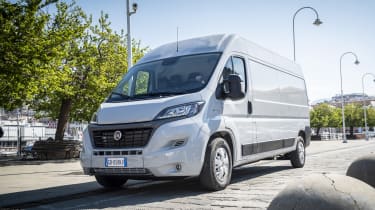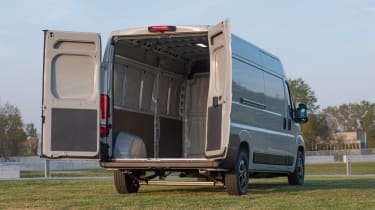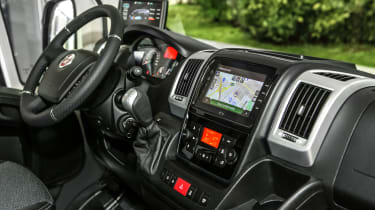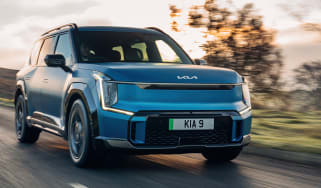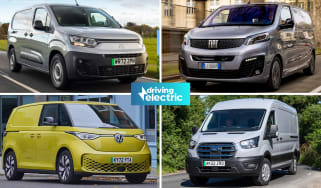Fiat E-Ducato review
Fiat’s first electric van will suit many businesses well, thanks to a choice of body styles and a range of up to 230 miles – although it has a hefty price tag
Pros
- High payload
- Bodystyle options
- Decent performance
Cons
- 47kWh model has limited range
- £15,000 premium for larger battery
- Ford E-Transit set to be better value
| Model | Range | Wallbox charge time | Rapid charge time |
|---|---|---|---|
| 47kWh | 146 miles | 4hrs 50mins (0-100%, 11kW) | 50mins (0-80%, 50kW) |
| 79kWh | 230 miles | 8hrs (0-100%, 11kW) | 1hr 25mins (0-80%, 50kW) |
Electric vans are big business now, with most manufacturers producing zero-emissions versions of their best selling light commercial vehicles. The latest to offer its business customers a slice of the electric pie is Fiat, with the E-Ducato.
Like its vast array of large electric van rivals, including the Mercedes eSprinter, Citroen e-Relay, Peugeot e-Boxer, Renault Master E-TECH and the upcoming Ford E-Transit, the E-Ducato is best suited to ‘last-mile’ delivery jobs, mostly in cities.
In place of the typical diesel engine, the E-Ducato features a single electric motor that produces 121bhp and 280Nm of torque. While you only get one motor and power output option, the E-Ducato is available with either a 47 or 79kWh battery, for a claimed range of up to 146 or 230 miles in urban conditions respectively.
Unlike some of its rivals, the E-Ducato isn’t just offered in panel-van form; it’s available in the same range of body styles as its diesel counterpart, with a total of 24 possible configurations including panel-van, chassis-cab and passenger minibus versions.
The panel van is available in three different heights (H1, H2 or H3), three different body lengths (5,413, 5,998 or 6,363mm) and three different wheelbase lengths (3,450, 3,800, 4,035mm). Load volumes for the panel van start at 10 cubic metres, and can go up to 17, with a maximum payload of 1,885kg for all versions.
The E-Ducato also features 270-degree opening rear doors, a sliding side door and several anchor points in the cargo area, as well as a fixed full-width steel bulkhead between the cabin and the rear. The battery is mounted under the cargo floor, so it doesn't rob any load volume.
Driving the E-Ducato is a fairly relaxing affair, with the smooth electric powertrain providing you with enough power to easily get up hills and keep up with traffic – although that may change when you’ve got a heavier payload in the rear. Overall, visibility in the panel-van version we drove was great, and the high driving position offers a good view ahead.
There are three driving modes (Normal, Eco and Power), allowing you to maximise range or motor power as needed depending on the job at hand. The E-Ducato also features E-Coasting and E-Braking regenerative systems, which feed energy into the battery when slowing down.
Charging is also fairly quick: businesses with access to an 11kW wallbox or power outlet can top up the 47kWh version in just under five hours, while the larger 79kWh battery takes around eight hours to fill at the same speed. The E-Ducato is also capable of rapid charging, so if you can find a 50kW public charger, it'll take 50 minutes to recharge the 47kWh van to 80%, while the same task will take close to 90 minutes for the 79kWh battery.
Up front, there's plenty of space for three. Standard kit on the entry-level version includes a five-inch touchscreen with DAB and Bluetooth, as well as automatic climate control, a tablet holder, a USB port, a fixed full-width steel bulkhead, heated mirrors, LED lighting in the load area and twin-leaf rear suspension.

Stepping up to eTecnico trim gets you a seven-inch touchscreen with Apple CarPlay, Android Auto and sat nav, as well as a rear parking camera with sensors, embroidered headrests, front foglights, heated power-folding door mirrors, LED daytime running lights and a leather steering wheel.
At this point, it’s worth noting the prices for the E-Ducato, because while the entry-level version of the panel van with the 47kWh battery starts from £47,675 (excluding VAT, with the plug-in van grant deducted), the larger 79kWh battery adds a hefty £15,000 to that. And that’s before you even consider upgrading to the more generously equipped eTecnico trim level.
In comparison, the forthcoming Ford E-Transit undercuts the entry-level E-Ducato by £5,000, yet has a range of 196 miles and can charge more than twice as fast as the Fiat – up to 115kW. All of which might be factors to consider for businesses that can wait until the Ford launches in spring 2022.
However, even with the E-Transit’s impending arrival, the E-Ducato is worth a closer look if you’re in the market for a large van and thinking of ditching diesel. With a good amount of standard kit and a variety of body choices, E-Ducato is capable of serving plenty of businesses of all types.

